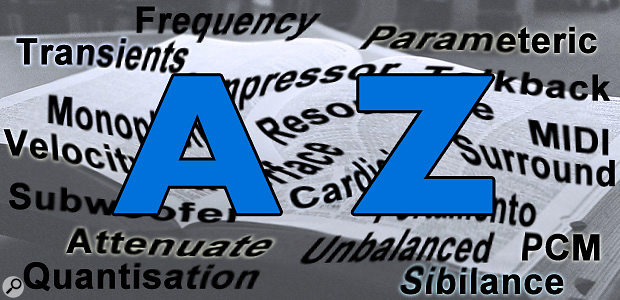You are here
Glossary
see Capacitor Microphone
A material that provides a low resistance path for electrical current.
A specific shape of drive unit diaphragm intended to push and pull the air to create acoustic sound waves. Most bass drivers use cone-shaped diaphragms, where the electromagnetic motor of the drive unit is connected to the point of the cone, and its outer diameter is supported by some form of flexible membrane.
An alternative term for mixer (See also Desk).
A compound designed to increase the conductivity of electrical contacts such as plugs, sockets and edge connectors. (cf. De-Oxidising Compound)
A form of microphone, sometimes also known as a Bug, which picks up sound vibrations mechanically, through the surface it is placed in contact with, rather than through the air.
Type of MIDI message used to translate continuous parameter changes, such as from a pedal, wheel or breath control device.
A variable voltage signal typically used to control the pitch of an oscillator or filter frequency in an analogue synthesizer. Most analogue synthesizers follow a one volt per octave convention, though there are exceptions. To use a pre-MIDI analogue synthesizer under MIDI control, a MIDI to CV converter is required.
A device which transcodes audio signals between the analogue and digital domains. An analogue-to-digital (A-D) converter accepts an analogue signal and converts it to a digital format, while a digital-to-analogue (D-A) converter does the reverse. The sample rate and wordlength of the digital format is often adjustable, as is the relative amplitude of analogue signal for a given digital level.
A mathematical process whereby the characteristics of one function (or signal) are imposed upon a second function (signal) , to produce a third function which combines both of their characteristics. (See Convolution Reverb). This process is performed in the digital domain by multiplying each individual sample value of a source signal with the impulse response of the wanted effect signal, so that the characteristics of the latter are imposed on the former.
A computationally demanding, but very accurate method, of creating artificial reverberation derived from real acoustic spaces with all their natural complexity. In essence, a reverberant space is measured to obtain its unique impulse response. That impulse response is then convolved with a 'dry' (reverberant-free) source signal to create an output signal which contains the original (dry) source signal with the desired room's reverberation characteristics imposed upon it. The convolution process is performed in the digital domain and involves multiplying each individual sample of the source signal with the impulse response of the convolving signal. The same technique can be employed to impose the characteristics of any other audio signal processing or signal-shaping device onto a source signal, such as the characteristics of legacy equalisers, compressors, tape recorders and so forth.
A method used by software manufacturers to prevent unauthorised copying.
Central Processing Unit - the number-crunching heart of a computer or other data processor.
A term sometimes used to refer to early digital equalisation algorithms running at base sample rates (44.1/48kHz) which had to curtail the HF band response to avoid exceeding the Nyquist limit. Consequently the frequency and phase response of the HF filter band sounded different to the analogue equivalent. Improved signal processing techniques and oversampling have largely fixed this issue in modern designs.
Slang term relating to malfunction of computer program.
Relating to the waveform characteristics of an AC signal such as an audio waveform. It decribes the ratio between the peak amplitude and the RMS level. The 'peakier' or more dynamic the signal, the greater the crest factor. Crest Factor is normally expressed in decibels.
A pure sine wave has a crest factor of 1.414 or 3.01dB, while a triangle wave is 4.77dB and a square wave 0dB.
A set of audio filters designed to restrict and control the range of input signal frequencies which are passed to each loudspeaker drive unit. A typical two-way speaker will employ three filters: a high-pass filter allowing only the higher frequencies to feed the tweeter, a low pass filter that allows only the lower frequencies to feed the woofer, and a second high-pass filter that prevents subsonic signals from damaging the woofer.
The frequency at which one driver ceases to produce most of the sound and a second driver takes over. In the case of a two-way speaker the crossover frequency is usually between 1 and 3kHz.
The ability to copy or move sections of a recording to new locations.
The frequency above or below which attenuation begins in a filter circuit.
see Control Voltage
One complete vibration (from maximum peak, through the negative peak, and back to the maximum again) of a sound source or its electrical equivalent. One cycle per second is expressed as 1 Hertz (Hz).

